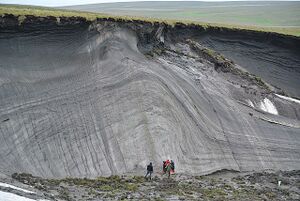Permafrost: Difference between revisions
No edit summary |
No edit summary |
||
| Line 7: | Line 7: | ||
==Continuety of Coverage== | ==Continuety of Coverage== | ||
Permafrost ranges in all different sizes and thicknesses. The average thickness can range from one meter to over 1500 meters [4]. The thickness of the active layer depends mainly on the moisture content, varying from less than a foot in thickness in wet, organic sediments to several feet in well-drained gravels. Permafrost is more widespread and extends to greater depths in the north than in the south. It is 1,500 meters (5,000 feet) thick in northern Siberia and 740 meters (about 2,430 feet) thick in northern Alaska, and it thins progressively toward the south [4]. | |||
[[File:Permafrost in Herschel Island 007.jpg|thumb|Permafrost_in_Herschel_Island_007]] | [[File:Permafrost in Herschel Island 007.jpg|thumb|Permafrost_in_Herschel_Island_007]] | ||
Revision as of 21:25, 9 May 2022
Permafrost is a permanently frozen layer below Earth’s surface. It consists of soil, gravel, and sand, usually bound together by ice and can be found on land and below the ocean floor. Permafrost usually remains at or below 0°C (32ºF) for two or more years. It is found in areas where temperatures rarely rise above freezing [2]. Permafrost occurs in many different forms with various amounts of ice and is mainly found in areas near the Arctic. In Alaska, about 80 percent of the ground has permafrost underneath it. In the Northern Hemisphere, regions in which permafrost occurs occupy approximately 25% of the land. The upper surface of permafrost is called the permafrost table. In permafrost areas, the surface layer of ground that freezes in the winter and thaws in summer is called the active layer [4].
Permafrost Zones
Permafrost is widespread in the northern part of the Northern Hemisphere, where it occurs in 85 percent of Alaska and 55 percent of Russia and Canada, and covers almost all of Antarctica. In addition to its widespread occurrence in the Arctic and subarctic areas of Earth, permafrost also exists at lower latitudes in areas of high elevation. This type of perennially frozen ground is called alpine permafrost. The largest area of alpine permafrost is in western China, where 1,500,000 square km (580,000 square miles) of permafrost are known to exist [4].
Continuety of Coverage
Permafrost ranges in all different sizes and thicknesses. The average thickness can range from one meter to over 1500 meters [4]. The thickness of the active layer depends mainly on the moisture content, varying from less than a foot in thickness in wet, organic sediments to several feet in well-drained gravels. Permafrost is more widespread and extends to greater depths in the north than in the south. It is 1,500 meters (5,000 feet) thick in northern Siberia and 740 meters (about 2,430 feet) thick in northern Alaska, and it thins progressively toward the south [4].
Continuous Permafrost
Continuous permafrost is a continuous sheet of frozen material, usually underlying 90-100% of the landscape. Continuous permafrost extends under all surfaces except large bodies of water in the area. Siberia has continuous permafrost [2].
Discontinuous Permafrost
Discontinuous permafrost is broken up into separate areas, usually covering 50-90% of the landscape. This includes numerous permafrost-free areas that increase progressively in size and number from north to south. Near the southern boundary, only rare patches of permafrost have been found to exist [4]. Some permafrost, in the shadow of a mountain or thick vegetation, stays all year. In other areas of discontinuous permafrost, the summer sun thaws the permafrost for several weeks or months. The land near the southern shore of Hudson Bay, Canada, has discontinuous permafrost [2].
Effects of Climate Change
Warming since the late 1960s has been observed in permafrost temperature profiles from many locations. Over the past several decades, permafrost temperatures have generally warmed in lowlands and mountains. While the impacts of climate change on permafrost vary at regional and local scales, permafrost thawing has been observed in many locations around the world [1]. Thawing is an effect of climate change caused by the positive feedback loop from the overall warming. Erosion happens when permafrost thaws because soil and sediment are easily washed away without ice-binding them together. When the temperature of permafrost rises above 0ºC, it starts to thaw. Generally, the mineral and organic components of the former permafrost will remain solid. Therefore, in regions with more ground ice, thawing permafrost may result in more of a change to the land surface, and vice versa [2]. As the permafrost thaws, it can turn into a mud slurry that cannot support the weight of the soil and vegetation above it. This leads to infrastructures such as roads, buildings, and pipes being damaged. Additionally, organic matter currently frozen in the permafrost will start to decompose when the ground thaws, resulting in many years worth of methane and carbon dioxide being emitted into the atmosphere [1]
References
[1] Climate Change Indicators: Permafrost. 2022, March 31. . Environmental Protection Agency. https://www.epa.gov/climate-indicators/climate-change-indicators-permafrost.
[2] National Geographic Society. 2012, October 9. Permafrost. https://www.nationalgeographic.org/encyclopedia/permafrost/.
[3] Pewe, T. L. (n.d.). Climatic change. Encyclopedia Britannica, inc. https://www.britannica.com/science/permafrost/Climatic-change.
[4] What is permafrost? 2021, June 4. . https://www.permafrost.org/what-is-permafrost/.

